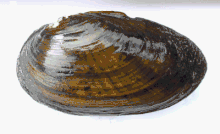Unio crassus
Unio crassus, the thick shelled river mussel, is a species of freshwater mussel, an aquatic bivalve mollusk in the family Unionidae, the river mussels. [3]
- Subspecies
- † Unio crassus jaeckeli Modell, 1950
- † Unio crassus klemmi Modell, 1957
| Thick shelled river mussel | |
|---|---|
 | |
| Unio crassus from Lužnice River, Czech Republic | |
| Scientific classification | |
| Domain: | Eukaryota |
| Kingdom: | Animalia |
| Phylum: | Mollusca |
| Class: | Bivalvia |
| Order: | Unionida |
| Family: | Unionidae |
| Genus: | Unio |
| Species: | U. crassus |
| Binomial name | |
| Unio crassus | |
Ecology
As part of newly discovered reproductive behaviour, this mollusc crawls up to the edge of the water, exposing its excurrent aperture, and then lets loose a stream of water. The fountain of water often contains glochidia, and it is suggested that this spurting behavior may facilitate dispersal of mussel larvae[4] (video).[5]
Decline
The thick shelled river mussel declined during the 20th century everywhere in Europe due to deteriorating water quality,[6] habitat fragmentation and host fish limitation.[7]
Distribution
Its native distribution is Europe and Western Asia.[1][8]
- It is mentioned in annexes II and IV of Habitats Directive.
- Croatia
- Czech Republic - in Bohemia, in Moravia,[9] endangered (EN).[10][11] Its conservation status in 2004-06 was unfavourable (U2) according to a report for the European Commission in accordance with the Habitats Directive.[12]
- Finland - in southern Finland. Vulnerable.[13]
- France[14]
- Germany - critically endangered (vom Aussterben bedroht)[15] In Germany this bivalve has disappeared from 90% of its former range.
- Netherlands - locally extinct. In the Netherlands it has not been seen alive after 1968 and is most likely extinct in that country.[16][17]
- Poland - endangered[18]
- Slovakia - nearly threatened[19]
- Sweden - very rare[20]
- Denmark - believed to have been extirpated until rediscovered in Odense River in 2003. The Odense River population is estimated to number c. 3000 individuals and subsequently it has been rediscovered from Suså River where the population size is unknown (might also survive in a couple of other rivers, but this remains unconfirmed).[21][22]
References
- Lopes-Lima , M.; Kebapçı, U.; Van Damme, D. (2014). "Unio crassus". IUCN Red List of Threatened Species. 2014: e.T22736A42465628. doi:10.2305/IUCN.UK.2014-1.RLTS.T22736A42465628.en. Retrieved 12 November 2021.
- "Unio crassus Philipsson in Retzius, 1788". Integrated Taxonomic Information System. Retrieved 13 July 2017.
- MolluscaBase eds. (2023). MolluscaBase. Unio crassus Philipsson, 1788. Accessed through: World Register of Marine Species at: https://marinespecies.org/aphia.php?p=taxdetails&id=1044116 on 2023-01-09
- Vicentini, Heinrich (2005-11-01). "Unusual spurting behaviour of the freshwater mussel Unio crassus". Journal of Molluscan Studies. 71 (4): 409–410. doi:10.1093/mollus/eyi045. ISSN 0260-1230.
- Karel Douda (2017-10-26), Spurting Mussel (Unio crassus), archived from the original on 2021-12-19, retrieved 2017-10-26
- Douda, Karel (2010). "Effects of nitrate nitrogen pollution on Central European unionid bivalves revealed by distributional data and acute toxicity testing". Aquatic Conservation: Marine and Freshwater Ecosystems. 20 (2): 189–197. doi:10.1002/aqc.1076.
- Douda, Karel; Horký, P.; Bílý, M.; Gompper, Matthew; Johnson, Jerald (2012). "Host limitation of the thick-shelled river mussel: identifying the threats to declining affiliate species". Animal Conservation. 15 (5): 536–544. doi:10.1111/j.1469-1795.2012.00546.x.
- "Unio crassus Philipson, 1788". Fauna Europaea. Fauna Europaea Secretariat, Museum für Naturkunde, Berlin. Retrieved 13 July 2017.
- (in Czech) Horsák M., Juřičková L., Beran L., Čejka T. & Dvořák L. (2010). "Komentovaný seznam měkkýšů zjištěných ve volné přírodě České a Slovenské republiky. [Annotated list of mollusc species recorded outdoors in the Czech and Slovak Republics]". Malacologica Bohemoslovaca, Suppl. 1: 1-37. PDF.
- Juřičková L., Horsák M. & Beran L., 2001: Check-list of the molluscs (Mollusca) of the Czech Republic. Acta Soc. Zool. Bohem., 65: 25-40.
- Red List of the molluscs (Mollusca) of the Czech Republic http://mollusca.sav.sk/malacology/redlist.htm
- Dušek J., Hošek M. & Kolářová J. (2007) Hodnotící zpráva o stavu z hlediska ochrany evropsky významných druhů a typů přírodních stanovišť v České republice za rok 2004-2006. - Ochrana přírody, 62(5): appendix 5:I-IV. (in Czech)
- "Threatened and Near Threatened molluscs". 2001. Archived from the original on 2013-05-11.
- "Recherche de sites par espèce: Invertébrés: Unio crassus (Unio crassus)". 2007. Archived from the original on 2007-09-21. Retrieved 2007-05-15.
- Glöer P. & Meier-Brook C. (2003) Süsswassermollusken. DJN, pp. 134, strana 109, ISBN 3-923376-02-2
- MinLNV>Dutch Ministry of Agriculture, Nature and Food Quality - Nature Law - Bataafse stroommossel (Unio crassus). Accessed at the ministries website
- "Anemoon > Flora en Fauna > Soorteninformatie". www.anemoon.org.
- Polish Red Data Book of Animals http://www.iop.krakow.pl/pckz/opis.asp?id=130&je=en Archived 2007-03-10 at the Wayback Machine
- (in Czech) Měkkýši (Mollusca) České republiky a Slovenska Archived 2012-05-29 at archive.today
- "Thick shelled river mussel - Naturhistoriska riksmuseet". Archived from the original on 2007-03-13. Retrieved 2007-03-28.
- "Tykskallet malermusling (Unio crassus)". Naturstyrelsen (Ministry of Environment). Retrieved 18 October 2023.
- "Sjælden ferskvandsmusling fundet på Sydsjælland". TV2 Øst. 13 June 2008. Retrieved 18 October 2023.
External links
Wikimedia Commons has media related to Thick shelled river mussel.
This article is issued from Wikipedia. The text is licensed under Creative Commons - Attribution - Sharealike. Additional terms may apply for the media files.
